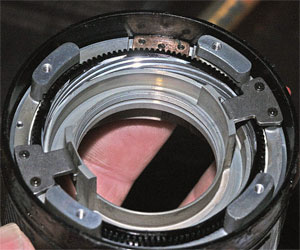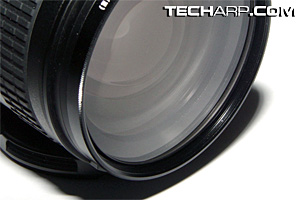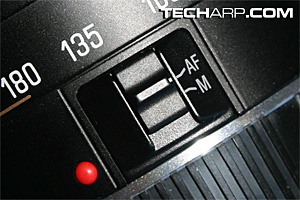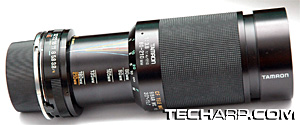Damaged Filter Rings
When lenses get knocked about, the filter rings are usually the part most likely to bear the brunt of the force.
If the filter ring is metal, it may become dented if the force is great. Otherwise, it will merely be scratched. But if the filter ring is made of polycarbonate, then knocking it on a hard surface will very likely crack or chip it. Sometimes, part of the filter ring may actually break off.
If you do not intend to use filters on the lens, then this is not a big issue.
You can, of course, use this defect to bargain the price of the lens down. ![]() But if you intend to use filters on the lens, then you must evaluate if the
damage can be repaired satisfactorily.
But if you intend to use filters on the lens, then you must evaluate if the
damage can be repaired satisfactorily.
Dented metal filter rings can be repaired by a good service technician. Sometimes, it can be straightened out enough to fit a filter, sometimes not. It really depends on the degree of damage, and the skill of the technician. The cost of repairing it should be cheap though.
Cracked or broken polycarbonate filter rings are actually less of a problem than dented metal filter rings. You can get away with a cracked filter ring as long as you attach and remove your filters carefully. A plastic filter ring with a missing part is also not much of a problem as the remaining screw threads are often enough to hold the filter in place.
However, damaged filter rings, whether metal or polycarbonate, will likely reduce the value of the affected lenses. This is good if you can live with it because you can often use it to bargain down prices. But it also works against you if you intend to sell the same lens in the future.
Loose Switches
Many lenses have switches that control certain features of the lens. For example, the AF-M (auto-focus or manual) switch.
Used lenses may come with loose switches. So, make sure you check the switches. Make sure they can lock into place properly.
If the lens has a loose switch, check if the switch still works. It's not too bad if it's just merely loose. Certain switches (like the AF-M switch above) are unlikely to be used often. So, you can simply tape them into place.
But if you need to use the switch often or if it doesn't work at all, then you will have to send the lens in for repair. This may not cheap, so take that into consideration before buying the lens.
Dust Inside The Lens
You will probably find dust inside older lenses, especially telephoto zoom lenses and push-pull zoom lenses. You can check for it by looking through the lens at a bright source of light. You will need to flick the aperture pin to open up the aperture.
But before you check for dust inside the lens, please clean off the dust on the front and rear elements! Otherwise, you may mistaken those dust particles for dust inside the lens.
Dust near the front element are less of a problem than dust closer to the rear element. But this is normally not a problem unless there is a lot of dust. Then, you may notice a loss of contrast.
Please note that internal dust will not appear as dots on the actual picture. If you see any dots on the pictures you take, they would be from dust on the sensor.
Although it may be unsightly, dust inside the lens is not a big problem because it generally won't have an effect on the picture quality. Plus, it can be easily cleaned by a service technician. The cost of cleaning out dust from inside the lens is low and often, the technician will clean out the dust automatically whenever you send your lens for servicing.
Tight Or Gritty Rings
 |
In some lenses, the focus and zoom rings may become a little tight, especially if the lens has been put in storage for a long time.
Dust can also get lodged in the helicoid threads. Then you will get a gritty sensation when you turn it.
Try turning the zoom and focus rings one at a time. They should move smoothly and quietly.
If the action is tight or even gritty, you will need to send the lens in for cleaning and lubrication. This shouldn't cost much though.
Loose Zoom Action
Push-pull type of zoom lenses have a tendency to develop a loose zoom action over time. Try turning the lens
end over end. If the zoom action is loose, the zoom ring will move of its own
accord. No, it's not a poltergeist. It's just a loose zoom action. ![]()
Although this will not affect the lens optically, it is certainly a nuisance to have the zoom ring move so easily. Of course, the degree of looseness varies from lens to lens. So, you will need to evaluate how bad it really is and weigh that against the price. This problem usually cannot be repaired cheaply, although it can be "fixed" using the the barrel tape trick.
This trick involves taping the barrel of the lens over which the zoom ring slides. You will probably have to apply a few layers of tape but be methodical about it - check the zoom ring's looseness after each application. Eventually, you should be able to get the zoom ring to slide smoothly, without any free play.
Damaged Zoom Action
In lenses that have taken a good knocking, the zoom action may be damaged. In such cases, the lens may not be able to achieve its full zoom range.
To check for damaged zoom action, simply twist the zoom ring back and forth. Make sure the lens is capable of achieving its full zoom range. If it cannot do so, then the zoom action is damaged. You should also check for rattling sounds or focus problems since the shock that damaged the zoom action could also affect the lens elements or focusing helicoid.
If you have an external flash unit, like the Nikon SB-910 AF Speedlight or the Canon Speedlite 600EX-RT, you can use it to read the exact focal length from the lens at any particular point in its zoom range. Just turn on your external flash and it will display the lens' current focal length. Twist the zoom action from one end to the other end and use the external flash's readings to verify the lens' zoom range.
You can still use a lens with a damaged zoom action, if that is all that is wrong with the lens. There should be nothing optically wrong with it. All you have to live with is the limited zoom range. Such lenses can be repaired but the repair cost and the hassle of sending the lens for repair may not be worth the discount you get. So, unless you are getting it at a real bargain, it would be best to avoid such damaged lens.
Damaged Focusing Helicoid
 |
In some old lenses or lenses which have taken a good knocking, the focusing helicoid may be worn or damaged. The problem may manifest as focus problems or noises when the lens is trying to focus.
To check, we must first start with a camera that is not known to have any auto-focus issues. Yes, the camera itself can be at fault. If your camera receives a hard enough knock to misalign the mirror, it may not focus properly with some lenses. If in doubt, try with an alternate camera.
First, try auto-focusing on various objects at different zoom lengths (if it's a zoom lens). This is important because a damaged focusing helicoid may be fully functional for most of the zoom range but will refuse to focus from a certain point onwards, resulting in a restricted auto-focus range. You should also try focusing on something far away, like the sky or a distant building.
If the lens cannot lock focus or back focuses at any point during your test, then there is a problem with the focusing helicoid. It could merely require some lubrication, or it could be worn out or damaged enough that you have to replace it.
You can consider buying the lens if the seller is willing to offer it to you at a firesale price. Replacing the focusing helicoid will set you back quite a bit, as it is a precision-machined part. But if all you needed to do was to get it lubricated, then you got lucky. Still, it's best to avoid such a lens if you can help it.
Support Tech ARP!
If you like our work, you can help support out work by visiting our sponsors, participate in the Tech ARP Forums, or even donate to our fund. Any help you can render is greatly appreciated!
<<< Introduction, Pros & Cons, Tackling The Issues, Missing Parts : Previous Page | Next Page : Damaged Lens Motor, Malfunctioning IS, Oily Aperture Blades, Sticky Aperture Blades >>>
Support us by buying from Amazon.com! |
|
| Grab a FREE 30-day trial of Amazon Prime for free shipping, instant access to 40,000 movies and TV episodes and the Kindle Owners' Lending Library! | |







 Add to Reddit
Add to Reddit





